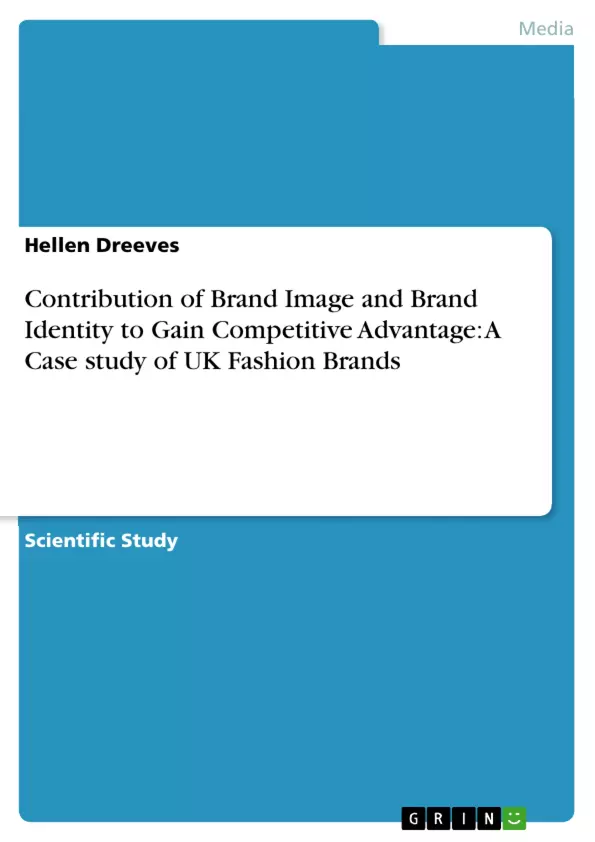The main purpose of the present study was to inquire into the contribution of brand image and brand identity for attaining competitive advantage. For the purpose of the same a case study on fashion industry was taken with a few established and globally recognised fashion brands existing in London.
The review of literature indicates that one of the sources for attaining competitive advantage could be the parameters as identified by customer perception model evolved out of the value-cascade positioning; such as the product characteristics, price, promotional activities of the fashion firm and reaching the target audience. The reason being they mostly remain invisible and at times difficult to copy. It is also evident from the data presentation and analysis that the intangible sources as referred in the literature review can also viewed through to gain brand image and brand identity and further lead the fashion industries to gain competitive advantage; they become the most imperative resources.
Though an attempt has been made in the fourth chapter to establish relationship between brand images and brand identity its lead to attain competitive advantage could not be explored scientifically, but sufficiently explored with case studies. The case studies were established fashion brand with global recognition. The collected data supported the methodology of secondary data source as well as with interviews.
Subsequent analysis of the data has identified a theoretical model that is proposed as the findings of the present study.
As a bottom line it is found by the researcher that the brand image and brand identity leads to competitive advantage.
Inhaltsverzeichnis (Table of Contents)
- 1.0 Introduction
- 1.1 Introduction
- 1.2 Background of the Study
- 1.3 UK Fashion Industry: An overview
- 1.4 Definition and Importance of Brand and Fashion
- 1.4.1 What is Fashion?
- 1.5 The Importance of Brand Positioning
- 1.6 Brand Image and Brand Identity
- 1.7 Problem Statement
- 1.8 Research Questions
- 1.9 Aims and Objectives
- 1.10 Research Structure
- 2.0 Literature Review
- 2.1 Introduction
- 2.2 UK Fashion Industry
- 2.3 Understanding the customer for Brand Image and Brand Identity
- 2.4 Values-Attitudes-Motives-Behaviour Cascade
- 2.5 Brand Positioning
- 2.6 Summary
- 3.0 Research Methodology
- 3.1 Research Approach
- 3.2 Qualitative Research
- 3.3 Deductive Versus Inductive Research
- 3.4 Case Study
- 3.4.1 Case Study Selection
- 3.4.2 Case Study Analysis
- 3.5 Data Collection
- 3.5.1 Primary Data
- 3.5.2 Secondary data
- 3.5.3 Data Analysis
- 3.6 Validity and Reliability
Zielsetzung und Themenschwerpunkte (Objectives and Key Themes)
This dissertation aims to investigate the relationship between brand image, brand identity, and competitive advantage within the UK fashion industry. The study utilizes a case study approach focusing on established, globally recognized fashion brands in London. By analyzing secondary data and conducting primary research through interviews with brand managers, the dissertation explores the role of brand image and brand identity in achieving and sustaining competitive advantage in a dynamic and competitive market. Key themes explored in this work include:- The importance of brand image and brand identity in achieving competitive advantage.
- The role of customer perception and the value-cascade positioning model in understanding brand strategies.
- The use of case studies to illustrate the application of brand image and brand identity principles in real-world scenarios.
- The significance of intangible assets such as brand image and brand identity in the fashion industry.
- The challenges and opportunities associated with building and managing strong brand image and brand identity.
Zusammenfassung der Kapitel (Chapter Summaries)
- Chapter 1: Introduction This chapter introduces the dissertation, outlining the background of the study, the UK fashion industry, the definitions of brand and fashion, the importance of brand positioning, and the key concepts of brand image and brand identity. It also presents the problem statement, research questions, aims, objectives, and the structure of the dissertation.
- Chapter 2: Literature Review This chapter delves deeper into the theoretical framework of the study. It explores existing literature on the UK fashion industry, customer perception models, the value-cascade positioning framework, and the concept of brand positioning. The chapter provides a comprehensive overview of the relevant academic research, setting the stage for the empirical analysis that follows.
- Chapter 3: Research Methodology This chapter details the research approach employed in the dissertation. It discusses the use of qualitative research methods, the deductive and inductive reasoning approaches, and the case study methodology. The chapter outlines the selection of case study brands, the data collection methods, including primary and secondary data sources, and the data analysis techniques used. Finally, it addresses the validity and reliability of the research.
Schlüsselwörter (Keywords)
This dissertation explores the key concepts of brand image, brand identity, and competitive advantage within the context of the UK fashion industry. The research focuses on the application of these concepts in real-world settings through case studies of established, globally recognized fashion brands. The study utilizes customer perception models, value-cascade positioning, and qualitative research methods to analyze the relationship between brand image, brand identity, and competitive advantage. The key terms and concepts covered in this work include brand image, brand identity, competitive advantage, customer perception, value-cascade positioning, UK fashion industry, case studies, and qualitative research.- Citar trabajo
- Hellen Dreeves (Autor), 2012, Contribution of Brand Image and Brand Identity to Gain Competitive Advantage: A Case study of UK Fashion Brands, Múnich, GRIN Verlag, https://www.grin.com/document/279974



